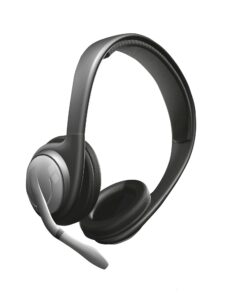I recently received an email from one of my students who was not sure where he should put the microphone in the PTE speaking test and wanted to know if there was anything he could do so that he would get a better score on the PTE academic speaking test.
I can’t give away too many details, but as it turns out, the student had been holding his microphone in a way that made him sound like he was speaking through a muffler! It’s important to realize that some simple adjustments can make all the difference when you’re taking your PTE exam. In this post, we’ll discuss how you can check the ideal position for the microphone in the PTE test for the utmost clarity before you even start recording.
A little information about PTE Speaking first
PTE is an English Language Test, in which, in the Speaking section, test takers read aloud given text, repeat sentences, describe a given image, re-tell a lecture and answer short questions. You will be given a microphone in your exam, and you would be using it to submit your answers to the test. Apart from its quality, position in front of the mouth, voice clarity, and familiarity with how it is controlled also play an important part. It is often found that candidates often underestimate the importance of the microphone and use it in the wrong way which can severely reduce their score. Here, I will explain how you can avoid it and get great results in the PTE exam.
You can learn more about PTE speaking and practice PTE questions for free here.
Why microphone position is important?
The PTE Speaking section focuses on providing clear responses to the questions, so it’s vital that you maximize your clarity by picking a microphone position with excellent voice reception. The feedback we receive from fellow humans when we speak will be different depending on our volume, but that is not the case with computers. Pearson’s computers will take in what you say without giving you any updates about it.
Therefore, it is important to speak into the microphone with enough volume and clarity so that your voice sounds natural. You have to remember that if you place the microphone too close, it can interfere with your sound recording and produce an air puffing effect due to the bursts of air coming out or due to breathing sound. If it is too far away, your speech may be unclear and full of background noise. In either case, it can affect your pronunciation score thereby affecting your speaking score, reading score, and listening score. The best position for the microphone in the PTE Speaking Test can be easily found by using the following tips and tricks.
How can I test my microphone in the PTE speaking test?
First of all, you need to remember that the microphone you use in the test is used by many test-takers every week. They adjust it to make their voice clearer. But these microphones are fragile. They can get loose easily. Therefore, make sure that the microphone is working and there is no electrical static sounds. To check the clarity of your voice recording, you may need to listen back many times. If you hear any noises while doing this test, report it immediately and get a new microphone before proceeding.
Types of the microphone in the PTE speaking test
Broadly speaking, the microphone can be either a condenser microphone or a cardioid microphone, and based on their pick-up pattern we can classify them as Cardioid, Bidirectional or Omnidirectional microphones. When using a microphone, you should be aware of two types: one that looks like this with the prong parallel to your face and another which will look similar but can be angulated.
The first type of microphone used in PTE

When you put a microphone with a parallel prong on your head, the microphone stays parallel to your face. So if you get this type of microphone, point it at or near the corner of your mouth. Now before you start your test, make sure to record a short 10-second clip of your voice while facing the microphone. One way to evaluate the clarity of your speech is to use a template that includes describing an image and retelling a lecture. Listen closely for clarity and locations of any noise distracting from hearing what you are saying.
The second type of microphone in the PTE speaking test

The other type of microphone that comes with the headphones you get in the test is a bendable type, which can stretch up to your mouth. Now, the two primary factors that affect clarity are placement and breathing noise. The microphone should be placed at the lower border of the lower lip at two fingers’ distance from your mouth, which is the most sensitive and optimum position. At this position, the breathing noise will not interfere with the mic as well as your voice will sound loud and clear.
What if you have a problem hearing your recording?
If you’re having trouble hearing your recorded voice, you may need to adjust your microphone position a little bit. The best technique for adjusting the mic is to move it down or up to one notch from your current position. Try this a few times until you find your sweet spot. Once you have found the optimal position, do not change the mic position at any time in the test.
Never do this in your PTE speaking test
One of our students recently did something during their speaking exam that had a negative impact on the score. The worst part was he put the mic just above his nose, which is not what you should do to prevent distortion on your sound. Although this position might seem like a good solution for your breathing as you speak, it is the most insensitive microphone position. Therefore, if you want the best possible clarity in your words and especially if your voice is soft, you should never do this.
Conclusion
In conclusion, the ideal mic position depends on the type of mic you use. When you put a microphone with parallel prongs on your head, the microphone stays parallel to your face pointing to the corner of your mouth. If you have a microphone with a bendable prong, then the perfect mic position is to keep it at the lower border of the lower lip at least 2 fingers away from your mouth. You can take a practice test to check if you are putting the microphone in the correct position or not. By following these tips, you will be able to record your voice without any problem and use your speaking skill to get your desired score in your next PTE test.
When you put a microphone with a parallel prong on your head, the microphone stays parallel to your face. So if you get this type of microphone, point it at or near the corner of your mouth. Now before you start your test, make sure to record a short 10-second clip of your voice while facing the microphone. One way to evaluate the clarity of your speech is to use a template that includes describing an image and retelling a lecture. Listen closely for clarity and locations of any noise distracting from hearing what you are saying.
The second type of microphone in the PTE speaking test
The other type of microphone that comes with the headphones you get in the test is a bendable type, which can stretch up to your mouth. Now, the two primary factors that affect clarity are placement and breathing noise. The microphone should be placed at the lower border of the lower lip at two fingers’ distance from your mouth, which is the most sensitive and optimum position. At this position, the breathing noise will not interfere with the mic as well as your voice will sound loud and clear.
What if you have a problem hearing your recording?
If you’re having trouble hearing your recorded voice, you may need to adjust your microphone position a little bit. The best technique for adjusting the mic is to move it down or up one notch from your current position. Try this a few times until you find your sweet spot. Once you have found the optimal position, do not change the mic position during any time in the test.
Never do this in your PTE speaking test
One of our students recently did something during their speaking exam that had a negative impact on the score. The worst part was he put the mic just above his nose, which is not what you should do to prevent distortion on your sound. Although this position might seem like a good solution for your breathing as you speak, it is the most insensitive microphone position. Therefore, if you want the best possible clarity in your words and especially if your voice is soft, you should never do this.
Conclusion
In conclusion, when you put a microphone with parallel prongs on your head, the microphone stays parallel to your face pointing to the corner of your mouth. If you have a microphone with a bendable prong, then keep it at the lower border of the lower lip at least 2 fingers away from your mouth. By following these tips, you will be able to record your voice without any problem and use your speaking skill to get your desired score in your next PTE test.
Do you know that you can practice more than 7000 questions for free?
At ROMAN PTE’s website, you can practice 7000+ questions completely free. All you have to do is to sign up for a free account. Then you can not only practice the questions but also watch videos, join live classes and upgrade to any suitable plan when you are ready.